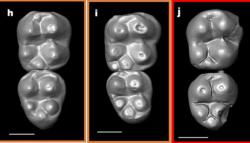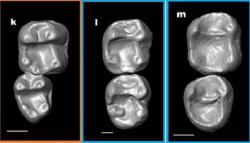Monkey teeth fossils hint several extinct species crossed the Atlantic
T![]() his article by V, School of Medical Sciences and , School of Natural Sciences, is republished from under a Creative Commons license. Read the .
his article by V, School of Medical Sciences and , School of Natural Sciences, is republished from under a Creative Commons license. Read the .
Most mammal fossils are visually unimpressive: a handful of teeth here and a fragment of bone there. Some are not even enough to identify the species they belonged to. But even a tiny fossil found in the right place can raise some really exciting questions about evolution.
In a new paper , an international team of researchers have described one such fascinating fossil, a set of monkey teeth from Peru. They belong to a species named Ucayalipithecus perdita (which we will call perdita). The name means βlost monkey of Ucayaliβ.
Perdita comes from a family called the whose members had previously never been found in the Americas. It has been dated to around 31.7 million years ago, and its closest relative was the roughly contemporary Qatrania wingi from Egypt. This suggests that perdita also most likely originally came from Africa.
This presents an obvious conundrum. How did monkeys so closely related come to be living as far apart as North Africa and South America, separated by 1,500-2,000 kilometres of ocean and significant tracts of land? The researchers, led by Professor Erik Seiffert at the University of Southern California, argue convincingly that the new fossils provide the first proof that there were multiple crossings of the Atlantic by ancient monkeys.
Scientists have actually been for decades. Evolutionarily speaking, there are two possible explanations: vicariance and dispersal. Vicariance happens when a widespread speciesβ range is fragmented by the appearance of a new barrier like a ravine or a river, while dispersal occurs when species migrate to colonise new lands.
Africa and South America as part of a supercontinent. Had monkeys been present, spread across it, then they would have been carried in different directions by the opening of the Atlantic. This would lead to divergence through vicariance. However, the initial opening of the Atlantic occurred , and the origins of the monkeys are . This explanation is now not widely accepted.
Instead, we are left with the possibility of long-distance dispersal across an ocean. The presence of living South-Central American monkeys suggests it must have happened at least once. We canβt be sure how, but one possibility is that a great storm might have ripped a chunk of vegetation from a coastal forest and transported it across the ocean. If this chunk had animal passengers, and if it moved fast, they might have survived to colonise new lands. This would, of course, be a very rare event, and even more rarely successful, though we do know .
Perdita, as the oldest South American monkey, has potentially pushed the timing of this dispersal back a few million years. More importantly, it has also shown that it happened more than once.
The importance of tooth shape
The paper on perdita is mostly about the new speciesβ anatomy, which the authors use to decide how it fits on its evolutionary tree. Monkey teeth are often studied to reconstruct relationships because they preserve well and differ between species.
The chewing surface of each tooth is covered in cusps (raised parts) and basins (dips) that give the tooth its distinctive shape. In the perdita paper, the authors compared their new fossil teeth with those of others from the same family and other living and extinct monkeys. We have modified one of their images to show just the molars in the lower jaw. Perdita is outlined in red, Egyptian teeth are outlined orange, and those in blue are from South-Central America.
 Image courtesy Erik SeiffertThe Egyptian teeth H and I (in orange) and those of perdita (J, in red) all have very pronounced cusps with small basins. If this were a landscape, it would be made up of a series of steep hills that sit tightly next to each other.
Image courtesy Erik SeiffertThe Egyptian teeth H and I (in orange) and those of perdita (J, in red) all have very pronounced cusps with small basins. If this were a landscape, it would be made up of a series of steep hills that sit tightly next to each other.
K ( in orange) is also from Egypt, and L (in blue) is from Argentina. These teeth have fewer cusps joined by crests that form a deep basin in the centre. The landscape here is one of mountains with continuous ridges surrounding a deep valley.
These teeth from Egypt and Argentina belong to monkeys of a different family. The final tooth M (in blue) is from a living South-Central American monkey (all the others we have shown are from  Image courtesy Erik Seiffertextinct ones). Comparing it to K and L shows the similarity between this living South American monkey and the two extinct ones. But clearly, perdita doesnβt fit in this group.
Image courtesy Erik Seiffertextinct ones). Comparing it to K and L shows the similarity between this living South American monkey and the two extinct ones. But clearly, perdita doesnβt fit in this group.
In short, we have two groups of South-Central American monkeys, one containing perdita and the other all the remaining species. These two groups are only distantly related to each other. Instead, each of them has close relatives in Egypt. This means two distinct monkeys must have made the journey.
The implications for evolution
The implications are startling. Perdita would have reached the Americas at roughly the same time as the relatives of living South-Central American monkeys and co-existed with them.
This coexistence may have been challenging, as closely related species often compete. But perdita survived long enough to travel inland a long distance and became well enough established to leave fossils.
The fact that these two groups of monkeys dispersed roughly simultaneosuly is also surprising given the supposed rarity of long-distance dispersal. At about this time, the polar ice caps expanded and sea levels fell. This lowering of sea levels may have been important in facilitating rafting.
Finally, to have survived a long-distance crossing, perdita and contemporaries must have been hardy creatures. Perhaps, like , they were physiologically adaptable to harsh environments. Or perhaps they relied on the behavioural flexibility that is so characteristic of living monkeys. However they managed it, surviving a transatlantic crossing suggests these species would have been extremely interesting animals.![]()
Publication date: 16 April 2020
